The All American SUN OVEN®
Hands-on testing, technical and consumer report
Until the mid 20th century, oven temperatures were estimated. A baker might put a piece of paper in and see how long it took to turn brown, or stick their arm in and see how long they could keep it in. 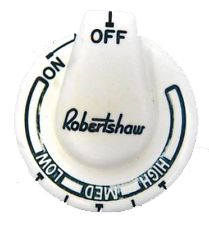 There were three oven temperatures mentioned in cookbooks: “slow” (low) for thin and delicate foods with low water content, “moderate” (med) for muffins and cookies, and “hot” (high) for crusty breads. It wasn't until after WWII that oven manufactures went all fancy industrial complex and put numbers on the dial. That the numbers really didn't mean much was overlooked and cooks were encouraged to believe that "350" meant that the oven, at every point within it, was maintained at 350ºF. At best, in the hypothetically well calibrated oven, 350ºF means 350ºF ±20 degrees. So realize that solar oven temperatures, like all oven temperatures, are approximate and that even with only three temperatures (slow, moderate, hot) that stuff still got baked back in the good old days. Modern cooks can get by with: slow (<275ºF), medium (275ºF to 350ºF), hot (350ºF to 450ºF), and burning hot (450ºF+) which is generally to be avoided.
There were three oven temperatures mentioned in cookbooks: “slow” (low) for thin and delicate foods with low water content, “moderate” (med) for muffins and cookies, and “hot” (high) for crusty breads. It wasn't until after WWII that oven manufactures went all fancy industrial complex and put numbers on the dial. That the numbers really didn't mean much was overlooked and cooks were encouraged to believe that "350" meant that the oven, at every point within it, was maintained at 350ºF. At best, in the hypothetically well calibrated oven, 350ºF means 350ºF ±20 degrees. So realize that solar oven temperatures, like all oven temperatures, are approximate and that even with only three temperatures (slow, moderate, hot) that stuff still got baked back in the good old days. Modern cooks can get by with: slow (<275ºF), medium (275ºF to 350ºF), hot (350ºF to 450ºF), and burning hot (450ºF+) which is generally to be avoided.
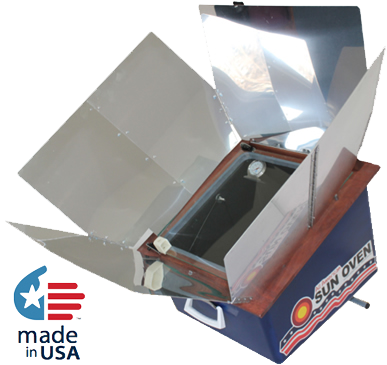 The All American SUN OVEN® is the new and improved successor to the veteran SUN OVEN® (developed 1986). On a good day, in Tucson, AZ, I can get 350ºF to 380ºF per the thermometer it comes with provided there is no moist food in the oven. The SUN OVEN® thermometer is at the top of the oven, the hottest spot, while at the bottom, where the food is, the temperature is much less. If a breeze is blowing, the SUN OVEN® thermometer reads closer to 310ºF (at the top) as the air movement blows away the hot air around the marginally insulated oven and thereby cools it (the outside of the oven is about 20ºF above ambient, so is far from super insulated, and the single pane glass cover is typically 170ºF to 190ºF on the outside surface as the glass provides less than R1 insulation). The gap between the oven and the reflector helps suck away the heat.
The All American SUN OVEN® is the new and improved successor to the veteran SUN OVEN® (developed 1986). On a good day, in Tucson, AZ, I can get 350ºF to 380ºF per the thermometer it comes with provided there is no moist food in the oven. The SUN OVEN® thermometer is at the top of the oven, the hottest spot, while at the bottom, where the food is, the temperature is much less. If a breeze is blowing, the SUN OVEN® thermometer reads closer to 310ºF (at the top) as the air movement blows away the hot air around the marginally insulated oven and thereby cools it (the outside of the oven is about 20ºF above ambient, so is far from super insulated, and the single pane glass cover is typically 170ºF to 190ºF on the outside surface as the glass provides less than R1 insulation). The gap between the oven and the reflector helps suck away the heat.
Still, it gets hot enough to serve as a slow cooker; the only issue being that you need to reposition the oven every 30 to 45 minutes to effectively track the sun. So it gets hot enough (on a good day) to hit medium temperatures. Stuff that is best baked in a "hot" oven (e.g. bread, pizza...), can still be baked on "medium," just not to "perfection" as some would define it. So bottom line: the SUN OVEN® is functional. It can cook stuff.
At sea level, boiling food gets you at most 212ºF, so the SUN OVEN® (whose air gets hotter) can cook but does not have the same functionality as a high-energy propane or natural gas oven. If there were truth in advertising, the All American SUN OVEN® would be called the "All American Sun 1/2 Oven" as only slow/low and low medium temperatures are achieved. At least "All American" clues you in to expect profit-driven hyperbolic advertising and claims.
Thermometers are good, can help assess oven conditions, but use one with a probe that you can put in the food being cooked/baked so you can see it and pay attention to the important temperature—not the one hanging at the top. Unfortunately, the SUN OVEN® is a sealed tight oven and the glass cover is relatively cool, so water condenses on it making the top thermometer unreadable (let alone a small dial one you stick in the food). To really know oven temperature, you need to use a digital thermometer with a probe inside and the readout display outside the oven. Otherwise toss the thermometers, develop look and feel experience, and cook the pre twentieth century way but without all the smoke.
For some reason all the water that condenses on the glass and runs down, creating a pool on the inside, is seldom mentioned (as in not at all on the SUN OVEN® website). If there were a market for an really expensive inefficient desalinator, perhaps it would be. But worth mentioning is that if you sat a bowl of salt water inside, you could drink the pool of water that would form in the bottom of the oven. With the growth of the survivalist market, SUN OVEN® can be expected to add "desalination" to its list of claims. At this time, however, no condensate forms, so far as they are concerned, and so they do not seal the inside bottom, which is metal riveted together. Water standing inside will leak through, wetting the insulation on the bottom. So if you put food in the SUN OVEN® having any water in it, make sure you put clear silicon sealant over the rivets and cracks. The wet insulation may not seriously affect performance, but if wet and not used for awhile, you won't want to know what is growing in the SUN OVEN®'s fiberglass insulation.
The claim, "Just like your home oven: Reaches Temperatures of 360° to 400° F!" is unquestionably true. It says so right there on the WWW. Unfortunately I don't live in Lake Havasu City and so have never tested the SUN OVEN® when it was 128ºF outside. I do live in Tucson where it often gets over 100ºF, but I tend to stay inside my swamp cooled shop on such occasions and so have only tested the SUN OVEN® at 108ºF ambient when, while pre-heating the oven with no food in it, I saw the temperature at the top per their dial reach 380ºF. While this may be "just like your home oven," mine has higher numbers on it. While the SUN OVEN® is not perfectly sealed, is not a pressure cooker, the temperature of anything moist, including the water that condenses on the glass and pools on the bottom, is not going to be greater than 212ºF and I have not seen the SUN OVEN® venting steam. Still, on a good day in Lake Havasu City, with care taken to keep the SUN OVEN® tracking the sun perfectly, and by wrapping the base in a sleeping bag, then I'm willing the concede the claimed 400ºF is reached per the only non-American made part, the cheap dial thermometer that the SUN OVEN® comes with. Otherwise they wouldn't make the claim. One of the first questions I get asked is, "How hot does it get?" My answer (I don't sell SUN OVEN®s) is, "About 250°F to 300ºF." I then add, "And that's hot enough for a solar slow cooker."
Higher than 212ºF oven air temperatures will cook food faster by getting it up to boiling point faster. Even if you don't live in Lake Havasu City, a SUN OVEN® will get over 212ºF on most sunny days. Lower oven temperatures just means it will take longer for the pot to boil—longer to cook whatever. The amount of food you can cook in a day will be less, but the SUN OVEN® is big enough to cook one meal for a couple or small family over the course of a day, so wasting sunshine is not an issue.
SUN OVEN®'s website states that 2 inch "food grade" fiberglass insulation is used. Again, absolute truth—the fiberglass insulation used is nominal 2 inch batts, but the wall thickness varies from 1.3 inches up to 2 inches at the very bottom front and back edge. Average thickness is about 1.5 inches, so the 2 inch insulation is compressed. No R value is given, but somewhat compressed fiberglass batting 1.5 inches thick would have an R-value of about 4.7. For the R-value of the system, factor in the less than 1 R-value of the glass which is about 1/6th of the surface area, so R 4 would be a fair claim. If you designed an RV travel trailer, much less a home, with such a low R-value, you would not legally be allowed to sell it.
The Real SUN OVEN® Temperatures
To find out how hot it really gets, an accurate thermometer is needed. I used a digital, data logging, two probe industrial strength one accurate to 0.15ºF. Since the data can be graphed, an accurate picture of what goes on in a SUN OVEN® can literally be offered.
Here's a typical day:
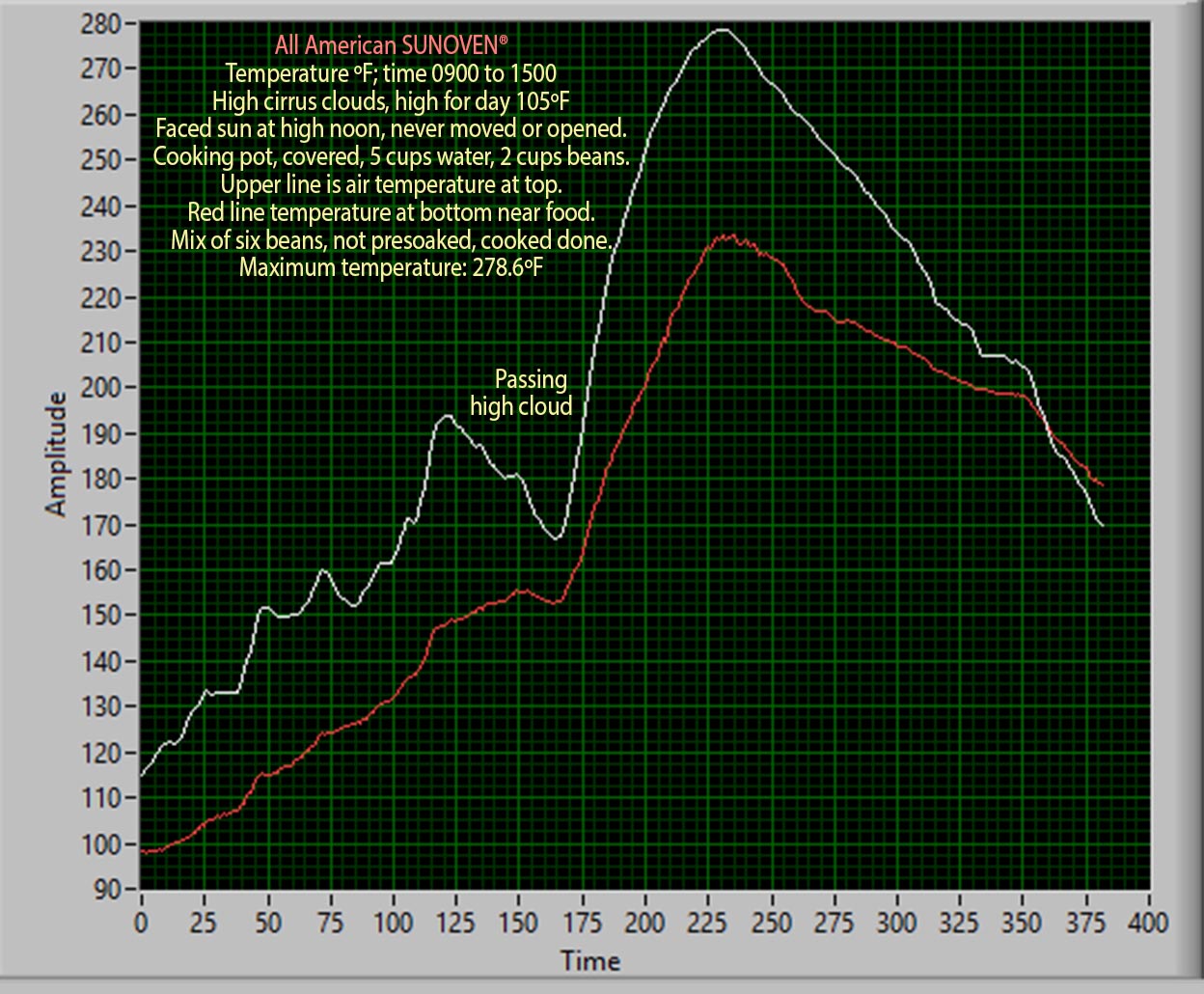
On a clear day, a smoother curve. For practical purposes, expecting a solar cooking enthusiast to go out in the noonday sun to move the SUN OVEN® every 30 minutes may work, but for a working stiff, don't expect too much. A more realistic strategy for using a solar slow cooker is to put the pot in on your way to work in the morning and have a hot meal waiting for you when you get home. Does this require some high-tech tracking device to follow the sun? No, just point the SUN OVEN® to where the sun will be and if no clouds, the sun will start to shine into the oven mid morning, pre-heating it, and keep getting hotter until it passes mid-point, then slowly cools off as it sets. If well insulated, the food would stay hot into early evening. If an after 5:00 meal is wanted, point to where the sun will be at 2:00 PM. SUN OVEN® mentions this possibility but such use is not consistent with their claim it is just like your gas oven in the kitchen, so no emphasis is given to this usage which is arguably the best use of a solar slow cooker.
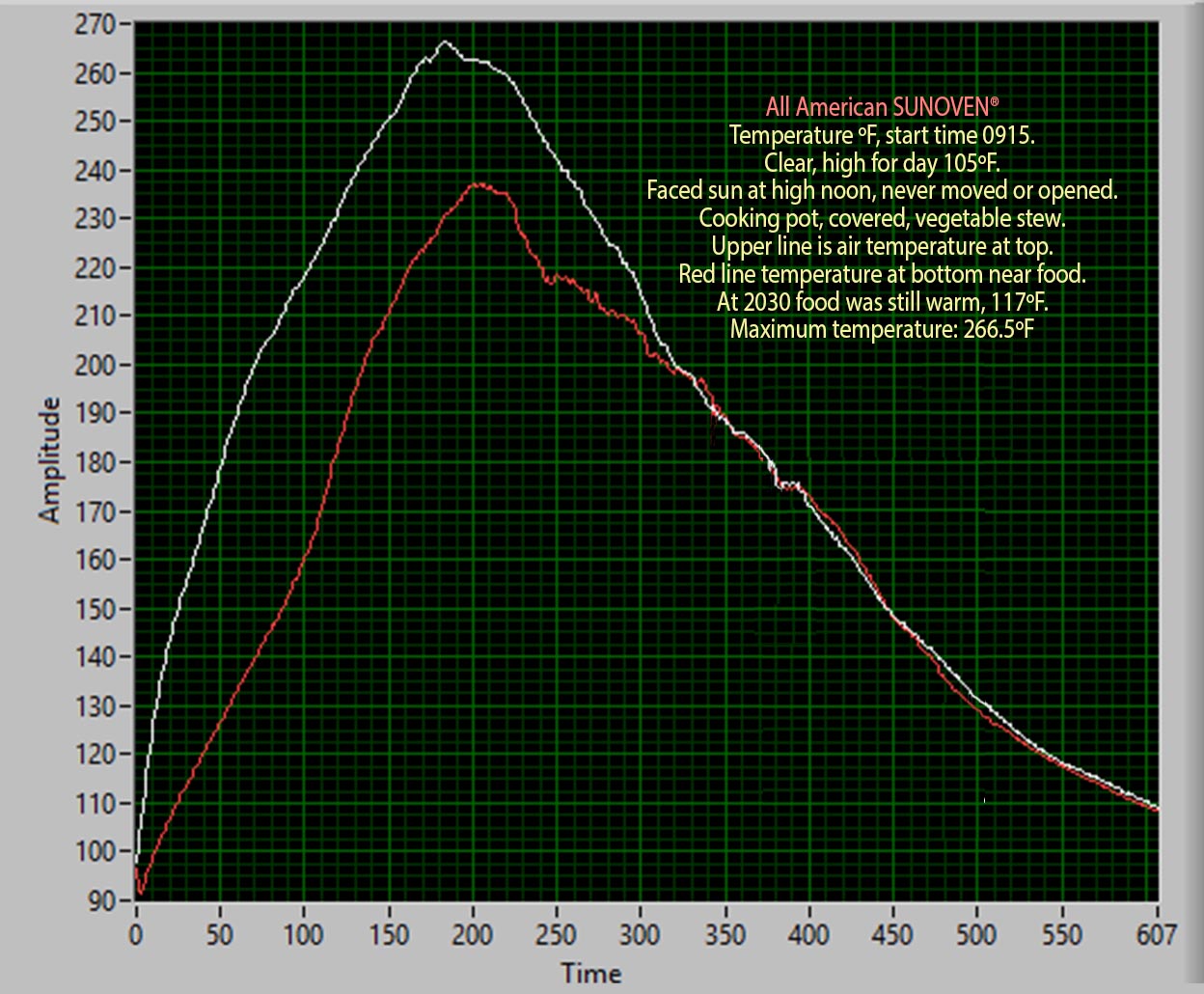
So here's the story of using a SUN OVEN® as it should be used by the non-enthusiast. One probe is in the pot and so temperature maxes out at 208ºF, the temperature water boils at the elevation of Tucson, AZ.

Without moving it, without any interventions, without being there, the pot boiled for 3 hours and food cooked and a hot meal was ready to eat. Note that the temperature, even at the very top, never gets close to the claimed "360ºF to 400ºF" temperature. But I didn't move the SUN OVEN® every 30 minutes to track the sun.
So how hot will it get if moved frequently to track the sun? Note below that even on a really hot day with frequent adjustments to track the sun, it still took 2 hours 20 minutes to bring 5 cups of water to a slow boil. Hence "solar slow cooker" is the better name. Still, the water was kept boiling for over 4 hours, longer than needed to cook most stuff, so all the effort was somewhat pointless as there was no big hurry to cook and eat.
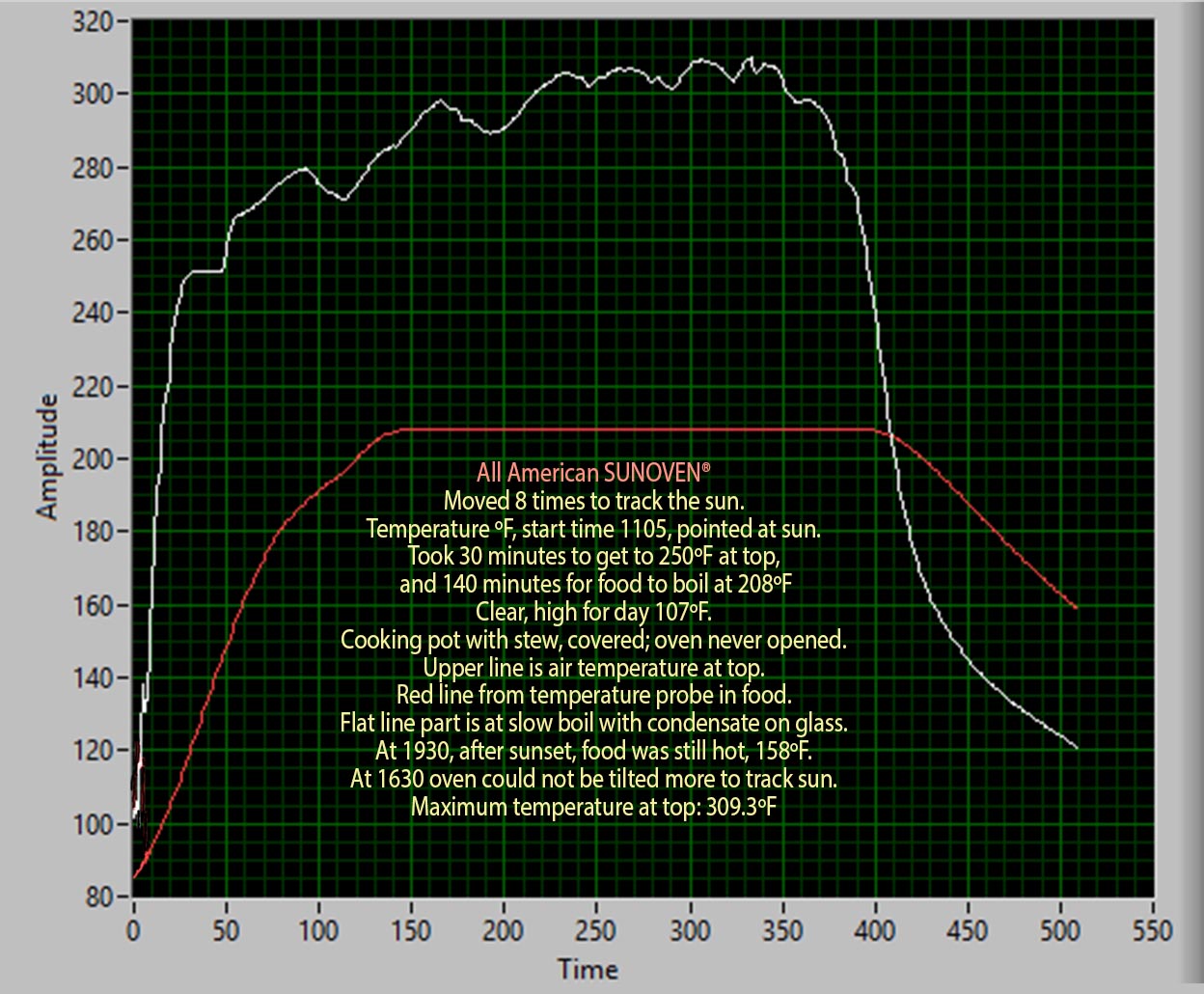
Wow, almost hit 310ºF. But that was with food in the oven. SUN OVEN® never said there was food in the oven when the expected 360ºF to 400ºF is reached. To give SUN OVEN® every chance, I waited for the hottest, most perfect day to test it. Of course, I left out the food. I suppose I could have put in some jerky so I could claim I was cooking when the high temperature record was within reach.
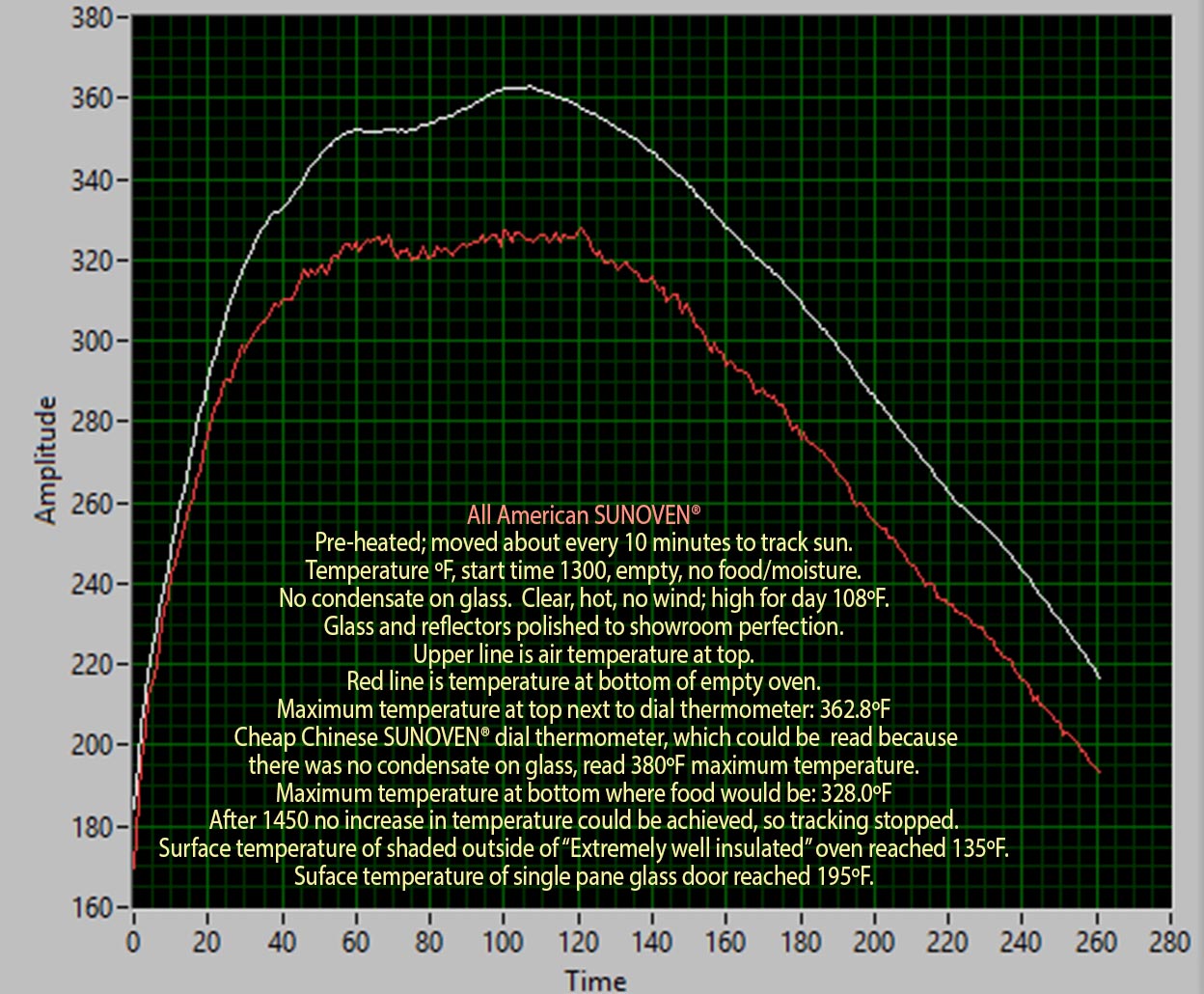
Due to heroic efforts, I can confirm that a maximum temperature between 360ºF and 400ºF is achievable. No food in the oven, but they never claimed there was. They have a photo on their site showing 410ºF on the dial. There is clearly no condensate on the glass, so obviously no food in the oven. Still, even if I lived in Lake Havasu City, or hung out in Death Valley in mid-summer, I don't think I could get the dial to read 400ºF. Clearly I have a defective dial thermometer that reads 20ºF lower than it should. I'll have to send it back and get one that reads at least 40ºF higher than my defective Amprobe TMD-56 Multi-Logging Digital Thermometer, 0.05% Basic Accuracy
reads.
To be clear, if this review seems harsh, the harshness is directed not so much at the product, but at the claims made on their website that amount to false advertising. I'm not nitpicking a few claims. The issue is the overall falsity of claims made that are apparently made because they sound good and will sell more product. The level of rhetorical deception should be a criminal offence and SUN OVEN® should be prosecuted. But their manner of doing business is all too common and legal. They are doing what succeeds in making them money, are merely doing what is becoming considered normal, even admirable, business practice. I'm not hostile to business. My father was a businessman, but so far as I know he was always honest and therefore never got rich beyond the dreams of avarice, nor wanted to.
As for the product, it works for what it is, a solar slow cooker. That it is seriously overpriced doesn't mean it doesn't work. As I fancy myself something of a designer, I will comment on the design. For slow cooking it gets hot enough, but using a single pane piece of glass is so 1986. A double pane door would cut heat loss by half. A travel trailer has to have R 7 walls, and that is minimal, but still better than sub-minimal. The All American is obviously the Original with a few add-ons, such as a plastic handle with a hole on the upper edge that allows a circle of sunlight to shine through. If the hole on the under side is within the spot of light, then the SUN OVEN® is tracking the sun. All good, but it is glued onto the glass in such a way that the reflectors, when folded, won't lay flat. A bit of redesigning would avoid this. Poor design annoys some but will be overlooked by most.
Other issues: The glass is held by two pieces of metal normally used to hold screens on windows. The glass has to be compressed to allow them to turn and hold the glass down. If the glass is hot, this can be painful. The screws holding them on, within three weeks of use, became loose and after re-tightening became loose again after a couple of uses, so I keep a screwdriver with the SUN OVEN®.
If the leg that tilts the SUN OVEN® forward to point at the non-noonday sun is extended all the way, it still doesn't point at the early or late sun. If it tilted any further forward it would tip over, which is to say that at full extension it is almost ready to tip over. If there is any wind, a slight gust would tip it over, and even flat, with no extension, a good gust will take it down. If on a table, it would come crashing down. The reflectors flap so much in a moderate breeze that I made wooden slates to stabilize them. I also, after each adjustment, tie the SUN OVEN® down as wind can come up at any time. Closed up, wind hasn't blown it off the table I put it on, but with reflectors up, it has to be tied down. An obvious improvement is to attach it to a lazy Susan and attach the lazy Susan to a support and make the reflectors so a good gust won't rip them off.
The SUN OVEN® is made with a 15 degree tilt, so it cannot point straight up. This is a temperate geography bias as in the tropics it cannot track the noonday sun. This is a design oversight. To track the sun anywhere, from sunup to sundown, a 90 degree range of tilt would be needed. The SUN OVEN® has a 34 degree range of tilt.
I ordered a SUN OVEN® with all accessories. Missing, however, was a bailing sponge. Up to a cup of water can run down the glass and collect in the oven. Tipping the SUN OVEN® over to get the water out gets it on the reflectors, wood, and glass. So after it cools off, I stand and use a bailing sponge intended for bailing small boats to get the water out. An alternative is to put a drain in the bottom, but I haven't gotten around to doing that to correct another design oversight. Another need-to-have are oven gloves.
If you have, or decide to buy one, there are modifications you could make to make it more functional. See: Modifying the All American SUN OVEN® article on the Solar Slow Cooker website.
If the SUN OVEN® were a high school science project I'd be willing to give it an A. If it were a first year engineering student's project, I'd give it a B. If a graduate student's or professional's offering, it would get a C, which is not good enough and I'd encourage them to keep on trying. As a business, although you're not suppose to be able to argue with success, I do and would have to give SUN OVEN® an F in terms of truth, justice, and the real American way which does not involve making exaggerated feel-good product claims just to make a buck.
The WAPI
When I decided to test the SUN OVEN® I went whole hog and got the Multi-Fuel WAPI (WAter Pasteurization Indicator). It is a small plastic vial with greenish wax in it solidified on one end. To use you pop the vial onto the bottom of the plastic case it comes in with the wax at the top. This is put in a pan of water and it floats with vial underwater. I assumed this was a third-party offering and would work as advertised: wax melts and the "150ºF (65ºC) for 6 minutes indicating that the water has been pasteurized and is now safe to drink" is true. I assumed that the wax at the top of the vial would be visible looking down on it, and when the color went away, the water was pasteurized.
When I got this product I didn't try it out. I focused on the SUN OVEN®. It was well after testing the SUN OVEN® that I looked at and noticed that the WAPI gadget is made by SUN OVEN® whose expertise apparently extends to water pasteurization technology. Since virtually every claim made by SUN OVEN® on their website needs to be changed from "sounds good" to " actually true," a red flag went up and I decided to test the WAPI.
I tried it out on the stove with a pan of water, and to simulate the SUN OVEN® I heated it on very low flame. My digital thermometer monitored the water temperature. I was unable to see the wax and opening the "high-temperature molded polypropylene case" (i.e. cheap plastic case with a hole in bottom--polypropylene melts at 266°F (130°C) period) didn't help as the off centered weight caused it to sink. So I cut the plastic hinge to remove the lid and watched for a color change. At 150ºF I saw no color change looking down so I tipped the floating case and saw the wax had melted. For practical purposes you have to reach in and tilt the case, if not remove from water, to see the vial which in a SUN OVEN® is completely impractical.
But by pushing the float to the far side of the pot and getting on my knees with a flashlight I was able to see when the wax melted without tipping it, even though squatting to look over the edge of the pot (and it had to be filled to the top with water so the angle was low enough) was tiring, as was holding the flashlight, still I was able to detect the melting of the wax. What I noted was that when the water got to 150.0ºF, that the wax melted within 1 minute. But the claim is clearly stated: "The wax melts and drops to the bottom of the tube when it reaches 150°F (65°C) for 6 minutes indicating that the water has been pasteurized and is now safe to drink." By repeating my test several times, however, I was forced to believe my eyes.
But where did the "150°F (65°C) for 6 minutes" come from? The Google only knows (but isn't telling). The big debate about water pasteurization is over whether you have to boil the water for at least 10 minutes, or is boiling it for less than 10 minutes acceptable to avoid certain death? Well, 10 minutes of boiling at 212°F is more than needed most of the time, per evidence (science), but it makes some people feel better so they'll keep on doing it.
Speaking of evidence, what might be called the LD90 for Hepatitis A is 149°F, the temperature at which 90% of the virus is killed if that temperature is maintained for 1 minute. So by achieving 150°F for nearly one minute, SUN OVEN® can claim that over 90% of Hep A virus will be killed (like maybe 92%). But that wouldn't sound good, and it isn't, so they'll not likely claim it. A defensible claim can be made that if water, all of it as in every place in the pot, reaches 160°F, then it is reasonably safe to drink.
A higher authority, the CDC (Centers for Disease Control), who employ scientists whose claims tend to be reality-based, says "158ºF for 30 minutes" is good enough, not 100%, but close enough. For practical purposes the CDC says boiling water (a rolling boil) for 1 minute is good enough provided you are doing the boiling below 6,562 feet (2000 meters). Higher up, water boils at increasingly lower temperatures, so above 2000 meters, boil for 3 minutes, and at Everest base camp, 10 minutes might be more like it.
So bottom line. The SUN OVEN® WAPI gadget fails to be usable. SUN OVEN® science fails. To pasteurize water using a SUN OVEN®: Use a non-data logging thermometer with a probe (cheaper than a WAPI), or forget the high tech. When steam condenses on the glass and starts to run down, the water, upon cooling, is safe to drink—both the water in the pot and the water that collects in the bottom of the SUN OVEN®.
Note to SUN OVEN®: If you don't like what I say, mention to your lawyers that I have little money, so the expression "sue a rock" applies. Also, few, as in very few potential customers will read this, and fewer will be dissuaded from giving you their money. So the best response is no response, just continue to laugh all the way to the bank. If you want a mainly positive review, lower your price and rewrite everything you say in your promotional material to tell it like it is, as distinct from whatever your ad writer thinks sounds good. An obvious response to my test results is to claim that for the first time in the history of your company, for some unknown reason, a SUN OVEN® was shipped that had no insulation in it. But to anticipate, I disassembled my SUN OVEN® after testing and it has insulation.
